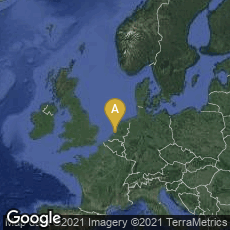

A: Leiden, Zuid-Holland, Netherlands
Traité de la lumière. Ou sont expliquées les causes de ce qui luy arrive dans la reflexion, & dans le refraction, et particulièrement, dans l'étrange refraction du cristal d'Islande. . . Avec un discours de la cause de la pesanteur by Dutch mathematician, astronomer, physicist and horologist Christiaan Huygens, published in Leiden in 1690, announced Huygens's wave or pulse theory of light, which he developed in 1676-1677. Huygens completed the Traité in 1678, but left it unpublished for twelve years, until stimulated by the appearance of Isaac Newton's Principia (1687) and by a visit with Newton in 1689.
Huygens conceived of light as an irregular series of shock waves or pulses proceeding with very great but finite velocity through the ether, a medium consisting of uniformly minute, elastic particles pressed closely together. Using the ether as the medium of light wave propagation, he showed that all points of a wave front originate partial waves, and thereby generate further wave motion; light, therefore, consists not of a transference of matter, but rather of a "tendency to move." This theory enabled Huygens to explain both reflection and refraction of light, but not the phenomenon of polarization, which he observed in his earliest studies of Iceland spar crystals (cristal d'Islande), and described in the present work.
Huygens's wave theory of light remained neglected for over 100 years, until Thomas Young resurrected it to explain optical interference.
Hook & Norman, The Haskell F. Norman Library of Science and Medicine (1991) no. 1139.